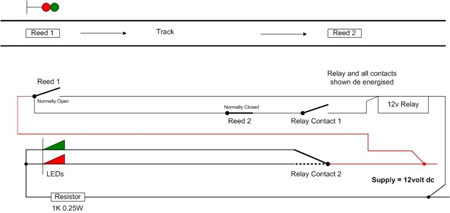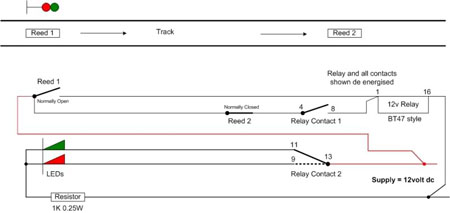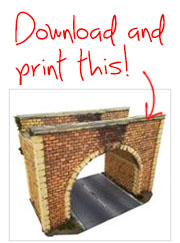Thought we’d start with a question that drives me nuts too:
“Good morning thanks for all the info so far .I.VE GOT A QUESTION FOR YA ITS. DRIVING ME NUTS WHY DO SOME ENGINES STAY ON TRACK AND OTHER FALL OFF ALWAYS AT THE SAME PLACE . I’VE RELAID TRACK 4 TIMES SO IF YOU HAVE ANY ANSWERS WOULD BE GREATLY RECEIVED, thanks again
Sincerely,
Ken”
“Hi Al,
I purchased a magnetic tray, which I can use for servicing my locos.
I can put the screws and other metal parts in it.
Result I don’t lose the screws and other metal fiddly parts.
Paul”
“Hi Al,
For realistic point operation, I insert insulated joiners about 18 inches leading into points on the switching tracks. If a train approaches the points, and the points are NOT set for thru, he train will stop at a realistic location before the points.
Its amazing how most of us use ‘junk’ and ‘REAL’ materials. Simple economics I guess !
Keep up the good work.
Steve”
“Alistair,
You have erroneously credited “Dennis” with the making Waves, when it was my artwork and submission about using the Silicone sealant, and expired credit card.
Thanks
Charles ”
Oops. Sorry Dennis.
“Hi Al,
Well this is where im at tonight. Looking to try and incorporate the turn table connected up to a shutting yard and a engine shed, but we will see how it goes, and with a 4year old helper (you hear her in the video) she makes the job that little bit longer bless 🙂
Shane”
“Let’s try this again.This is a diagram for relay and reed switch’s for signal’s:
“Alastair,
Attached, I hope, are two photographs I think you might enjoy.
One is of a working railroad here in Western Maryland. My wife and I have taken this tour and we loved it. The foliage in autumn is beautiful.
The other is a steam engine, #777 that you may have to keep watered all summer long.
Enjoy
Richard”
Hope you liked today’s post. Please keep them rolling in.
And don’t forget to bag a great deal with the latest ‘ebay cheat sheet‘.
Best
Al









Check the gauge of your wheels or the distance from flange to flange to see if it is within specifications.
Reagards Ronald jones
Hi Alastair
have had problems with long wheel base steamers on some points and curves
but if the area has been relaid several times might be the model railroad gremlins lol
seriously, you are a little vague on the area is it the same loco, etc
had wheel flange problems before too deep and kept hitting nail heads in one area
joints in the middle of curves posed a problem with expansion and contraction also (leaving a little gap cured that one)
I have the same problem with 2 identical Bachman V3 Tank locos. 1 goes over 1 set of points at any speed, the other derails at the slightest excuse. But the pony trucks were a bit tight. Having freed them off, the problem is greatly minimised. To solve it completely I need to alter the track position slightly.
Other locos will work fine facing one way, and fall off facing the other (Hag BLS Ae 8/8 with single powered unit).
I suggest the root of Ken’s problem might be that the centre of gravity of engines is ignored. I guess that the section of track might be on a bend or deviation. See if running the engines in the reverse direction still make them fall off. If not correct the balance of the locos.
Cheers,
Phil
Hi Ken,
Assuming that the track has been relaid level and with no ‘dogleg’ bends in it, there are 2 possible causes which spring to mind. Firstly, you may be trying to run old style stock on finescale track whereupon the deeper flanges will ride up over the sleeper chairs, particularly on points/turnouts. The second cause may be the gauge of the wheels of your stock may be incorrect. Best solution for this is to buy a wheel gauge (not very expensive and extremely useful) and adjust the inside distance between the wheels till the gauge will just slip between them.
I had a short wheelbase tank loco which ‘waddled’ alarmingly and derailed until I adjusted it with the gauge. and now it performs well.
Hope this helps,
John
If he is using Bachman Engine the front wheels are coming of the tracks. Spring on the front wheels is not good. I put two weights (Automobile tyres led balancing weights.) on the front wheels underneath on both sides. I just used the UPS tap to hold it. It works fine. This is the problem on Bachman Engines.
I bought a brass back to back gauge, which you slide between the wheels, if its loose, wheels too far part, if its to tight wheels too close together. These gauges can be found in the ads in most model rail mags.
You could try to record this area of track. A video comes in handy just for these situations. Take this curve slow…remember these are trains not race cars….make several different recordings until you can see what is causing these to jump off the track then make your adjustments from then on. Another method is to bank the curve using no more that 0.15″ shims every 20 ties. Good luck
I also have a conundra.I have a rock island f7a beautiful shape but she has track problems as well.She wont go over rerailers,or the power section of the track.goes half way and jams there spinning wheels.So looks like i will get rid of this engine even if its a nice one.
the answer to the question on loco’s derailling is simple one, wheel back to back measurements more seen on steam than any other.
Ken, pretty good suggestions here so far. I would agree that if you have changed the track and still having problems get you an NMRA gauge and start with the loco’s and make sure they are in gauge and then check the track and make sure it is also. You didnt mention if there are any switches, make sure they are in gauge and no points are thick or not completely opening. Some locos are very forgiving and others are not.
small files are an absolute must have!! Good luck
Dugan
Hi,
check the back-to-back measurements of the wheels, some may be to narrow and as the loco crosses the points/joints the check rail pushes the flange up so it derails
back-to-back gauges are available in all scales/gauges and for a coouple of £ are a good invstment
respects
CHECK AND SEE IF THERE IS ANY ANGLE OR SLIGHT ELEVATION ON THE SURFACE YOU ARE LAYING TRACK ON. IF ON CORNER, THE RADIUS MIGHT BE TO SHARPE FOR THE ENGINES. REALLY NEED MORE INFORMATION AS TO RADIUS, ENGINES (STEAM OR DISEL) SURFACE TRACK IS LAYING ON ETC. THERE COULD BE EVEN A SMALL PIECE OF WOOD UNDER THE ENTIRE TRACK SURFACE CAUSING AN ELEVATION.
EMERSON SARTAIN USA
I’ll bet John and others have hit it on the head. Older locos had deep wheel flanges tro help keep them on the track. If you are using a lower profile track, which is now so very common, the deep flanges will kick the engine off track, accomplishing the exact opposite of the original intention. If this is the case you will need to change out the wheels and drivers.
Was the engine connected to a car?
I had a problem similar to this with a F7A connected to a long car.
due to the distance of the coupler from the wheel base, the coupler could not swing far enough and pushed the engine off the track.
You might have a combination of these problems. Checking the wheel and trucks as indicated previously is a good start, as well as the balance or weight of the engine. I would also check your foundation. If you primary base if plywood, hollow wooden door or similar material they have a great tendency to not be precisely level across the entire surface surface. Or a support or leg holding your layout might have pushed the surface out of level. Put a precise level at the point of the problem, checking both sides of the track individually and then checking the track across both rails. The engine that derails might have a tighter or shorter truck action. If the primary foundation is off a shim should correct it. Or if you can make a bypass around the area that works, leave the area and make it the scene of a train derailment. My mother always fixed my trains with a hammer. That’s why I had to buy all new trains when I left home and also why I became a professional crisis counselor!
I had a pair of steamers that did a similar thing at one particular section on my layout, like you I thought it was the track so I ulled it up and relayed but made the curve a bit more flowing by increasing the radius by an inch and a half, it cost a bit of scenery and a control tower had to be relocated but it seemed to fix the problem, I hope this is of some help. Good luck anyway!
I had the same problem, I discovered a little protusion of the motor mounting. (I have the motor replaced) when th engine turns left, that protusion traps the truck and it cannot straighten again.
Will take it back to the mechanic to see if he can file or bend taht protusion.
Good luck.
Paco Gayon
Two other suggestions. Check the lower arm on your Kadee style coupler
Some are too low and will snag the track,a nail head or any thing else that gets in the way. Also check the weight that the engine is pulling .If the weight is too much often an engine will torque to one side or try to go straight through a curve. Identical engines from different manufacturers will have different weight limits
Hi,
As per some other comments, you will probably find the wheel setting from new does not always match that to the type of track you are running on, it is worth you while investing in back to back gauges, these are not expensive and can solve a lot of rough running problems.
London,UK
Hi Ken, some Locomotives are not designed to go round sharp curves , for example Bachmann Branchline locomotives. I had the same problem with my layout. i first laid Atlas set track, and when I purchased a Hornby flying Scotsman, and a Bachmann 170 class DMU. i had to completely rebuild the main line. I used Hornby and Peco track when I rebuilt my mainline. i also replaced Atlas points with peco as I discovered that with Atlas points, the track is live no matter which way the point is set.
Some sound ideas here, the only suggestion I can add is to check if you have an insulated connector where it derails, I have given up using them and cut the track later and fill the gap with epoxy filler and smooth it off.
The track gauge should locate this problem.
As I am the proud owner of some very battered models I can freely add simple spring compensation to the leading drive wheels, this keeps them on the track and also helps with electrical contact and reducing wheel-spin. I don’t suggest this for your classy collectables though!
Cheers
Ralph
What to say thanks to all the people and there answers to some of the common problems they have faced with there layouts engines and just tracks.Ilove Alestar showing the hobby.I have been getting this for a while in my email and love it.But this is a great help to me and I know to alot of others. I hope there will be more of this kind of feed back and write about the hobby.THANKS TO YOU ALL.
I had the engine problem in making my layout. Some engines ran fine and others would derail at the same spot. Tried new track, old track and finally weight distribution might pay the real problem. Played with my lead weights that I made and it works find. I had the steam engine version of the engine jumping the track and the weight I put on it was at the nose of the train. Go figure? Just a newbie lost in space and the possibilities that I might help you pros..
Try to locate some carbon copying paper, nearly indigo in color. Next, find some very thin tracing paper. Sandwich the carbon paper between the thin layers of tracing paper and lay it over the problem area. If it is possible to manually push your loco over the problem area, it will look like a CTscan of your loco’s wheels; rail, ties, points, wheel to rail contact, and flange area contact points. I use this in “N” Scale and it realy narrows down the problem.
To answer Ken’s question, this is attributed to the turning radius of the loco truck. Given a smaller 18″ radius you will see that an engine with a Co-Co arrangement will ride over the rails at the quarter point of the curve, than a loco with a Bo-Bo arrangement (talking diesels here). The reason is that a Co-Co tends to continue to keep a straight path as the rails force it to turn, to a point where the wheel becomes a tangent to the curve and it will derail at that spot.
This also happens with 4-6-2’s with smaller dia. wheels, though some of the larger diameters will track along well. Definitely a no no with 2-10-0 or 2-8-2 etc.
The remedy is to go with min. 22″ curve on the inner loops which is typically where this happens.
One remedy I applied to my layout is to remove the mounting nails from the ties on the inside 18″ curves and let is free float up to the incoming and outgoing straight track that feeds the curve. This way the engine trucks naturally push on the free track and the play in the track allows the engine to negotiate the curve without falling off.
REALLY GOOD LOOKING.
Hi, I recently purchased a new loco that would derail every time at the same place. The curve was the only tight (18″0) left turn on my layout. I finally tracked down the problem to be not enough space for the bogies to turn inside the loco. I had to grind some of the material off the inside of the casing to provide enough clearance for the bogies not to foul the inside of the loco body.
I have a DC CN vintage i rebuilt.I have the same problem when i hook the 2 CN engine’s in tandum.Right turn’s forces the back engine to derail or pop the coupler.I have 10 DC engine’s i rebuilt and modified.slowly giveing them away.Shipping 2 to the UK .he pays shipping and can have them free.I willl keep 2 but rest go.